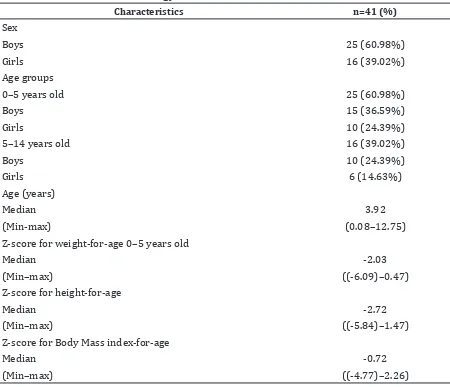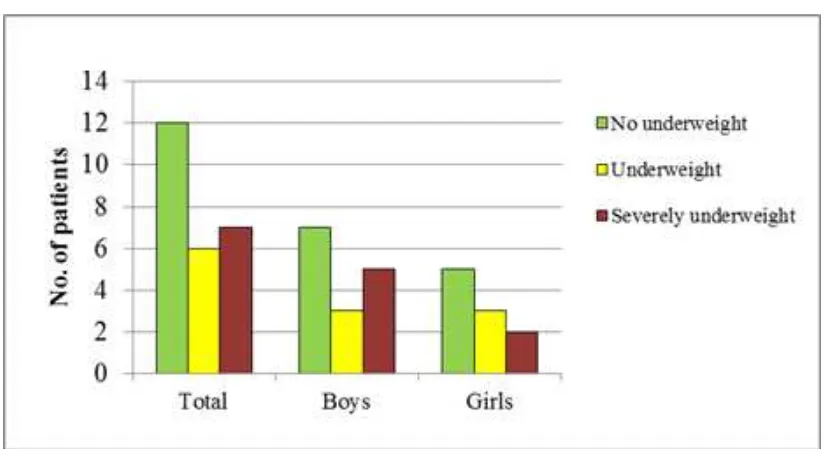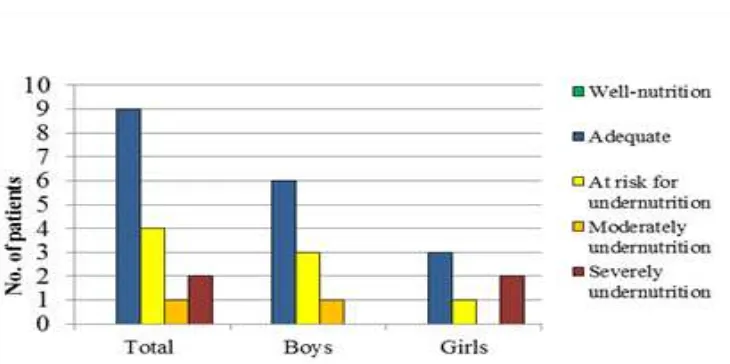Nutritional Status of Tetralogy of Fallot Patients at Dr. Hasan Sadikin
General Hospital Bandung
Gabriella Chafrina,1 Armijn Firman,2 Gaga Irawan Nugraha3
1Faculty of Medicine Universitas Padjadjaran, 2Department of Child Health Faculty of Medicine,
Universitas Padjadjaran/Dr. Hasan Sadikin General Hospital,Bandung, 3Department of Medical
Nutrition Faculty of Medicine Universitas Padjadjaran
Abstract
Background: Undernutrition is common in children with congenital heart disease (CHD), especially in developing countries including Indonesia. The objective of the study was to describe the nutritional status of children patients with Tetralogy of Fallot.
Methods: This was a cross-sectional descriptive study using 41 medical records of children aged 0–14 years old with Tetralogy of Fallot that visited pediatric outpatient department of Dr. Hasan Sadikin General Hospital in period of January to December 2013. The variable was anthropometric measurement, namely weight-for-age, height-for-age, weight-for-height, and body mass index-for-age. These anthropometric data were analyzed using statistics software, WHO Anthro, and WHO AnthroPlus and were classified based on nutritional status according to WHO. The collected data were displayed in percentage.
Results: There were more boys (60.98%) who had Tetralogy of Fallot compared to girls (39.02%). The percentage of undernutrition was 39.02% with 43.75% in 5–14 year old children. The percentage of stunting was 70.73% with 72% in 0–5 year old children. Meanwhile, the percentage of underweight was 52% in children aged 0–5 years old.
Conclusions: The percentage of undernourished children with Tetralogy of Fallot is quiet high. Undernutrition occurs more often in 5–14 year old children, while stunting occurs more often in 0–5 year old children. [AMJ.2016;3(2):298–303]
Keywords: Children, nutritional status, Tetralogy of Fallot
Correspondence: Gabriella Chafrina, Faculty of Medicine, Universitas Padjadjaran, Jalan Raya Bandung-Sumedang Km.21, Jatinangor, Sumedang, Indonesia, Phone: +6281316777415 Email: gab.chafrina@gmail.com
Introduction
Undernutrition is common in children with congenital heart disease (CHD), especially in developing countries including Indonesia.1
Tetralogy of Fallot, cyanotic congenital heart defects, accounts up to 10% from all CHD.2 This
case consists of 4 combinations of structural heart abnormalities, namely ventricular septal defect, pulmonary stenosis, right ventricular hypertrophy, and overriding aorta.3
Undernutrition can be caused by inadequate nutritional intake or absorption, excessive energy expenditure, frequent respiratory infections, limitation of growth potential and genetic syndromes.4 Generally, children need
energy for synthesis of proteins that really
confluence for their growth and development.
Tetralogy of Fallot will cause low level oxygen in blood that can disrupt the energy formation that leads to growth retardation.5,6
Treatment by surgery for Tetralogy of Fallot cases is recommended in young age,
so that significantly improve the children’s
nutritional status.1,7,8 The aim of this study was
to describe the nutritional status of children with Tetralogy of Fallot.
Methods
A descriptive cross-sectional study was conducted in 2014 using medical records of children aged 0–14 years old with Tetralogy of Fallot that visited pediatric outpatient department of Dr. Hasan Sadikin General Hospital from January–December, 2013. The study variables were described after getting permission from Health Research Ethics Committee. The medical records should meet the inclusion criteria which consisted
299
by history taking, physical examination, and echocardiography. The medical records were excluded when there were data about other chronic diseases, other congenital heart defects, or the medical records were incomplete. Samples were taken using total sampling method.
The anthropometric measurement, namely age, height-for-age, weight-for-height, and body mass index-for-age were analyzed using statistics software, WHO Anthro, and WHO AnthroPlus and were
classified based on nutritional status according
to WHO into well-nutrition (z score >1 SD), adequate nutrition (z score 1 to -1 SD), at risk from undernutrition (z score -1 to -2 SD), moderately undernutrition (z score -2 to -3 SD), severely undernutrition (z score<-3 SD). Stunting and underweight based on
height-for-age and weight-height-for-age were classified
into normal (z-score >-2 SD), stunted and underweight (z-score -2 to -3 SD), and severely stunted and severely underweight (z score <-3 SD).9 The collected data were displayed in
percentage
Results
There were 41 medical records that met the inclusion criteria. There were more boys (60.98%) who had Tetralogi of Fallot compared to girls (39.02%), and this case occured in a very young age (Table 1).
According to nutritional status, most of the patients were underweight (median z-score for weight-for-age for 0–5 years old was -2.03, median z-score weight-for-age based on sex for boys was -2.03 and for girls were -2.09).
Gabriella Chafrina, Armijn Firman, Gaga Irawan Nugraha: Nutritional Status of Tetralogy of Fallot Patients at Dr. Hasan Sadikin General Hospital
Table 1 Characteristics of Tetralogy of Fallot Patients
Characteristics n=41 (%)
Sex
Boys 25 (60.98%)
Girls 16 (39.02%)
Age groups
0–5 years old 25 (60.98%)
Boys 15 (36.59%)
Girls 10 (24.39%)
5–14 years old 16 (39.02%)
Boys 10 (24.39%)
Girls 6 (14.63%)
Age (years)
Median 3.92
(Min-max) (0.08–12.75)
Z-score for weight-for-age 0–5 years old
Median -2.03
(Min–max) ((-6.09)–0.47)
Z-score for height-for-age
Median -2.72
(Min–max) ((-5.84)–1.47)
Z-score for Body Mass index-for-age
Median -0.72
Moreover, most of the patients were from stunted to severely stunted (median z-score for height-for-age for 0–14 years old was -2.72 , for 0–5 years old was -3.1, and for 5–14 years
was -2.35 (stunted). Patient’s median z-score
for height-for-age based on sex for boys and girls were -2.68 and -2.73 respectively). On the contrary, the result of Body Mass index-for-age measurement showed a different result. Most of the patients had adequate nutrition.
Figure 1 to 5 represents the nutritional status according to various measurement, age groups (0–5 years old and 6–14 years old), and
gender.
The percentage of underweight (underweight and severely underweight) was 13 from 25 patients (52%). In boys, the percentage of underweight was higher than in girls (Figure 1).
The percentage of stunting cases (stunted and severely stunted) were 18 from 25 patients (72%). Similar to the previous nutritional status result, the percentage of stunting in boys was higher compared to girls (73.3% and 70%, respectively) (Figure 2).
Most of the patients were in adequate
Figure 1 Weight-for-Age in 0–5 Year Old Children with Tetralogy of Fallot
301 Gabriella Chafrina, Armijn Firman, Gaga Irawan Nugraha: Nutritional Status of Tetralogy of Fallot Patients
at Dr. Hasan Sadikin General Hospital
nutritional status (15 from 25 patients), but there were still 9 patients who were undernourished (at risk from undernutrition, moderately undernutrition, and severely undernutrition) (Figure 3). From the undernourished cases, most of the patients were boys (40%) including 3 patients who were at risk from undernutrition, 1 patient was moderately undernutrition, and 2 patients were severely undernutrition. On the other hand, the percentage of undernourished girls was 30% including 2 patients who were moderately undernutrition and 1 patient was severely undernutrition.
The percentage of stunting cases (stunted and severely stunted) was 11 from 16 patients
(70.73%). The percentage of stunting in boys were 7 from 10 patients (70%)including 4 stunted patients and 3 severely stunted patients. The precentage of stunting in girls was 4 from 6 patients (66.67%) (Figure 4).
The percentage of undernutrition (at risk from undernutrition, moderately undernutrition, and severely undernutrition) was 7 from 16 patients (43.75%). The percentage of undernutrition in boys was 4 from 10 patients (40%)including 3 patients at risk from undernutrition and 1 patient moderately undernutrition. The percentage of undernutrition in girls was 3 from 6 patients (50%) including 1 patient at risk from undernutrition and 2 patients severely
Figure 3 Weight-for-Height in 0–5 Year Old Children with Tetralogy of Fallot
undernutrition. Most of the patients were in adequate nutritional status (9 from 16 patients) (Figure 5).
Discussion
In this study, the percentage of undernutrition cases was 39.02%, which was 36% in children aged 0–5 years old and 43.75% in children aged 5–14 years old. This percentage was lower than another study conducted in Bandung10
(78.57%).This result might likely occured due to different methods for calculating nutritional status.
The percentage of stunted children was 70.73%, which was 72% in children aged 0–5 years old and 68.75% in children aged 5–14 years old. This result was higher than another study conducted in Bandung (25%).10 This
result might likely occured due to different methods for calculating nutritional status as well.
The percentage found in this study showed variability of nutritional status. This was explained by Okoroigwe11 that children
whose nutritional intakes are met with needs have normal nutritional status, but those whose nutritional intakes are not met with needs are stunted, underweight, and have undernutrition. Some children with normal weight-for-height, low weight-for-age, and low height-for age will have underweight as a result of their short stature (stunting), perhaps arising from a history of past malnutrition. In contrast, children with low weight-for-height, low weight-for-age, and normal height-for-age
will indeed have currently malnutrition with underweight and undernutrition, even though they are not stunting.12
The result of this study showed the importance of various nutritional status measurements in children, namely height, weight, and body mass index measurement
to analyze comprehensively of children’s
nutritional status. Those simple measurements could give important inputs or information to physicians and family members in early detection of malnutrition and Tetralogy of Fallotin developing countries. If malnutrition is undetected, it can worsen the disease.1
Furthermore, physicians should refer the patient to the hospital for surgery as soon as possible because early treatment of Tetralogy
of Fallot defects can have significant results
in acceleration of weight and height, with normalization of long-term growth and usually living a life free of major symptoms.2,8
This study had limitation, which was among other studies, this study was using medical records as source of data that could play an impact role in validity of the study. There were many medical records that did not meet the inclusion criteria. Moreover, there were no data of the growth and development measurements of the patients who underwent surgery.
It can be concluded that the percentage of undernourished children with Tetralogy of Fallot is quiet high. Undernutrition occurs more often in children aged 5–14 years old, while stunting occurs more often in children aged 0–5 years old.
303
References
1. Vaidyanathan B, Radhakrishan R, Sarala DA, Sundaram KR, Krishna R. What determines nutritional recovery in malnourished children after correction of congenital heart defects? J Am Acad Pediatr. 2009;124(2):e294–9.
2. Bailiard F, Anderson RH. Tetralogy of fallot. Orphanet J Rare Diseases. 2009;4(2):2–12. 3. Park MK. Pediatric cardiology for
practitioner. 5th ed. Philadelphia: Mosby;
2008
4. Sjarif DR,Anggriawan SL, Putra ST, Djer
MM. Anthropometric profiles of children
with congenital heart diseases. Med J Indones. 2011;20(1):40–5.
5. Baaker RH, Abass AA, Kamel AA. Malnutrition and growth status in patients with congenital heart disease. Iraqi Postgrad Med J. 2008;7(2):152–6.
6. NydeggerA and Bines JE. Energy metabolism in infants with congenital heart disease. Nutrition. 2006;22(7-8):697–704.
7. Vaidyanathan B, Nair SB, Sundaram KR, Shivaprakasha K, Rao SG, et al. Malnutrition in children with congenital heart disease (CHD): Determinants and short-term impact of corrective interventions. Indian Pediatr. 2008;45:541–6.
8. Tokel K, Azak E, Ayabakan C, Varan B, Aslamaci S, Mercan S. Somatic growth after corrective surgery for congenital heart disease. Turk J Pediatr. 2010;52(1):58–67. 9. World Health Organization. WHO child
growth standart. Geneva: World Health Organization; 2006.
10. Rahayuningsih SE, Garna H. Status gizi dan rasio mcgoon pada tetralogi fallot. MKB. 2011;43(4S):83S–7S.
11. Okoroigwe FC and Okeke EC. Nutritional status of preschool children aged 2-5 years in Aguata L.G.A of Anambra State, Nigeria. Int J Nutr Metab. 2009;1(1):9–13.
12. Daymont C, Neal A, Prosnitz A, Cohen MS. Growth in children with congenital heart disease. Am Acad Pediatr. 2013;131(1):e236–42.



